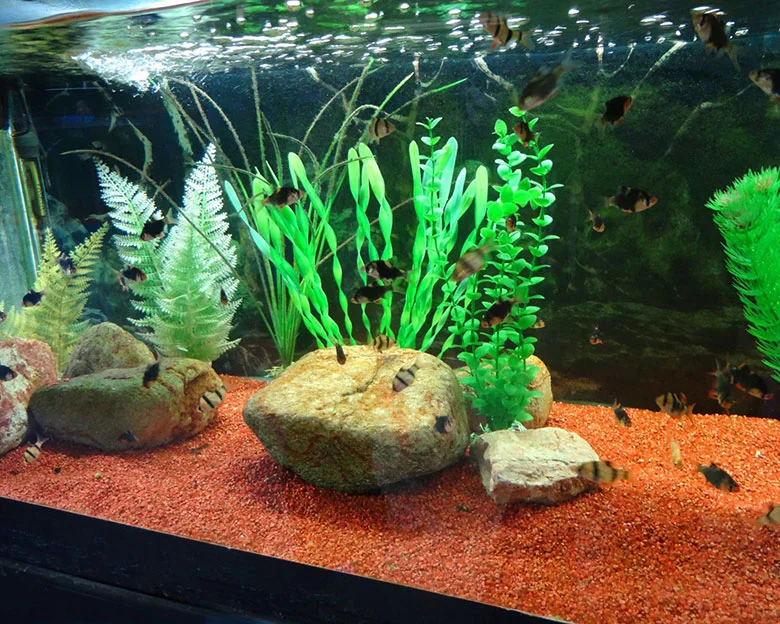Are you tired of looking at dull and dirty plastic aquarium plants in your underwater oasis and struggling to find an effective method for cleaning plastic aquarium plants? Keeping your aquatic plants clean is crucial to maintaining a healthy and attractive environment for your fish and other aquatic creatures. Luckily, there are three easy and effective cleaning methods that will have your aquarium plants sparkling in no time!
In this article, we will explore three proven cleaning techniques using simple household items such as vinegar solution, hydrogen peroxide, and bleach. We’ll also provide you with tips on how to use each method safely and effectively, as well as recommendations for cleaning tools and products.
With these simple and easy-to-follow methods, you’ll be able to maintain a beautiful and healthy underwater environment that you and your aquatic pets will love. So, let’s dive in and learn how to achieve sparkling aquarium plants with these three easy cleaning methods!
Key Takeaways
- Scrub brushes with plastic bristles and abrasion are effective for cleaning plastic aquarium plants.
- Vinegar solution is safe for cleaning soft algaes and silk leaves.
- Hydrogen peroxide is stronger than vinegar and safe to use directly in an aquarium, but may fade silk leaves.
- Bleach can be used to clean aquarium decor and equipment, but should never be used directly in the aquarium and requires thorough rinsing and soaking in dechlorinator water.
Why Clean Aquarium Plants?

You should clean your aquarium plants regularly to prevent algae buildup and ensure a healthy environment for your aquatic pets. This is discussed in Katherine Morgan’s article on cleaning plastic aquarium plants. Algae growth is a natural occurrence in aquariums, but excessive buildup can lead to problems such as decreased oxygen levels, water discoloration, and harm to your fish. By cleaning your plants on a regular basis, you can keep your aquarium looking sparkling clean while also promoting the health and wellbeing of your aquatic pets.
The importance of cleaning aquarium plants extends beyond just maintaining a clean and healthy environment. Clean aquarium plants provide numerous benefits for your fish. They provide shelter and hiding places for shy fish, and can even serve as a source of food for some species. Additionally, healthy plants help to absorb excess nutrients in the water, which can help prevent the growth of harmful bacteria and other microorganisms.
Overall, keeping your aquarium plants clean is an essential part of maintaining a thriving and beautiful aquatic environment.
Cleaning Tools and Supplies
Don’t forget to grab your favorite scrub brush and some vinegar or hydrogen peroxide before you start tackling those pesky algae spots on your plastic foliage. Choosing the right scrub brush is crucial to effectively cleaning your aquarium plants. Look for one with plastic bristles that won’t scratch or damage the plants.
It’s also important to label your brushes and only use them for aquarium cleaning to avoid contamination from other cleaning solutions. For hard-to-reach spots, a clean toothbrush can be used.
While vinegar is a great option for cleaning soft algaes like green dust or brown algae, it does have its limitations. Vinegar is not effective against tougher algae and may not completely remove all the buildup.
In these cases, hydrogen peroxide is a stronger cleaning option that is safe enough to use directly in the aquarium. However, it’s important to note that hydrogen peroxide may fade the colors of silk leaves on your plants.
Always rinse your plants thoroughly after cleaning and soak them in dechlorinated water to remove any traces of cleaning solution before returning them to your aquarium.
3 Effective Cleaning Solutions
For a more powerful cleaning solution, consider using hydrogen peroxide or bleach to remove tough algae buildup from your plastic aquarium decor and equipment. Vinegar is a safe option for soft algae, but for more stubborn buildup, peroxide and bleach will do the trick. Keep in mind that peroxide may fade the colors of silk leaves, so be cautious when using it.
When it comes to bleach, safety precautions must be taken. Only use plain chlorine bleach and never use scented, splashless, or color safe bleach. Bleach should never be used directly in the aquarium and any decor or equipment that has been cleaned with bleach should be rinsed thoroughly and soaked in water with extra dechlorinator to remove any traces of bleach. Follow the table below for a quick comparison of vinegar, hydrogen peroxide, and bleach as cleaning solutions for your aquarium plants and decor.
| Solution | Effectiveness | Safety |
|---|---|---|
| Vinegar | Effective for soft algae | Safe for aquarium plants with silk leaves |
| Hydrogen Peroxide | Stronger than vinegar | May fade colors of silk leaves |
| Bleach | Strongest cleaning solution | Must be used with caution and safety precautions |
Best Practices for Cleaning
By implementing these best practices for maintaining the cleanliness of your aquarium decor and equipment, you can ensure a healthy environment for your aquatic pets.
First and foremost, preventing algae growth is key to keeping your plants and decor looking clean and vibrant. This can be achieved by regularly checking and adjusting your aquarium’s lighting schedule, as well as limiting the amount of nutrients in the water through proper feeding and water changes. Additionally, placing your plants and decor in areas with good water circulation can help prevent stagnant areas where algae can thrive.
Another important aspect of maintaining a clean aquarium is proper brush maintenance. As mentioned earlier, it’s crucial to label and dedicate specific brushes for aquarium cleaning to avoid cross-contamination with any other cleaning solutions. It’s also recommended to replace your brushes periodically to ensure that they are still effective in removing algae and other debris.
Lastly, using a clean toothbrush for hard-to-reach spots can help ensure that all areas of your decor and equipment are adequately cleaned.
By following these best practices, you can ensure that your aquarium remains clean and healthy for your aquatic pets to thrive in.
Frequently Asked Questions
Can Live Plants Be Cleaned Using The Same Methods As Plastic Aquarium Plants?
Live plants require different cleaning methods than artificial plants due to their delicate nature. Benefits of live plants include natural filtration and oxygenation. Artificial plants can be scrubbed with vinegar or hydrogen peroxide, but live plants should be gently wiped with a soft cloth.
How Often Should Aquarium Plants Be Cleaned?
How often should you clean your aquarium plants? Regular cleaning benefits your plants by removing harmful debris and algae buildup, ultimately promoting a healthier aquatic environment. Tips for maintaining healthy aquarium plants include using safe cleaning methods, such as vinegar or hydrogen peroxide, and avoiding bleach on silk leaves.
Are There Any Natural Cleaning Solutions That Can Be Used Instead Of Vinegar Or Hydrogen Peroxide?
Looking for eco-friendly alternatives to commercial cleaners like vinegar and hydrogen peroxide? Try DIY cleaning solutions such as a baking soda and water paste or a salt and lemon juice scrub. These natural options can effectively remove algae without harming your aquarium plants.
Can Bleach Be Used To Clean Aquarium Plants With Silk Leaves?
Using bleach on silk aquarium plants can be effective, but it should be used with caution. While it can strip the color out of the silk leaves, it is a strong cleaner. Alternative methods for cleaning silk plants include vinegar and hydrogen peroxide.
What Are Some Signs That It’s Time To Clean Aquarium Plants?
Visual cues and foul odor are signs that it’s time to clean your aquarium plants. Prevention tips include regular water changes and avoiding overfeeding. DIY cleaning solutions like vinegar and hydrogen peroxide can help maintain their appearance.
Sparkle Your Aquarium Plants: Take Action and Maintain Their Beauty!
Congratulations! You now have the knowledge and tools to keep your aquarium plants looking their best.
As you may have discovered, algae can quickly accumulate on plastic plants, making them look dull and uninviting. However, with the three effective cleaning solutions we’ve discussed – vinegar solution, hydrogen peroxide, and bleach – you can easily maintain a healthy and beautiful underwater environment.
But wait, there’s more! While cleaning your aquarium plants is an important step in maintaining their appearance, it’s also crucial to remember that over-cleaning can be harmful to your fish. So, before you go on a cleaning spree, make sure to follow the best practices we’ve outlined to ensure the safety and well-being of your aquatic pets.
In the world of aquariums, the truth is that keeping your plants clean is an ongoing process. However, with the right knowledge and tools, you can make it a breeze.
So, put on your cleaning gloves, grab your supplies, and get ready to watch your aquarium plants sparkle like never before!

